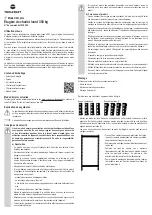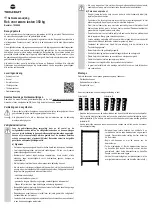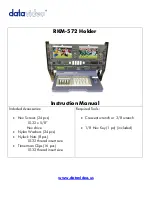
This is a publication by Conrad Electronic SE, Klaus-Conrad-Str. 1, D-92240 Hirschau (www.conrad.com).
All rights including translation reserved. Reproduction by any method, e.g. photocopy, microfilming, or the capture in
electronic data processing systems require the prior written approval by the editor. Reprinting, also in part, is prohibited.
This publication represents the technical status at the time of printing.
Copyright 2017 by Conrad Electronic SE.
*1530556_v1_0417_02_DS_m_4L_(1)
•
Take two longitudinal braces and connect them to the first set of braces. Each longitudinal
brace should be inserted at the same height as the corresponding cross brace. Ensure that
there is sufficient ground clearance for the first shelf.
• Connect the longitudinal braces to the second set of upright braces, ensuring that they are
inserted at the same height.
• Use a mallet or hammer to secure the longitudinal braces to the keyholes. To avoid
damaging the braces, place a flat piece of wood underneath the hammer. Place the piece
of wood diagonally across two braces to ensure that the force from the hammer is spread
evenly across the top of each brace (see diagram).
• Repeat this for all four corners.
• Repeat these steps to install additional braces at the desired height (not all braces are
shown in the diagrams).
• Insert the shelves into the braces.
• To install the top section of the rack, take two longitudinal
braces and two cross braces, and then gently insert the
lower knob on each brace into the top keyhole on the
lower section of the rack. Do not lock the braces in place.
Take an upright brace in orientation B with the foot facing
upwards and insert it into the top knob on the longitudinal
and cross brace. Repeat this step for all three ends with
the other upright braces. Start by inserting the cross
braces, and then insert the longitudinal braces.
• Use a mallet or hammer to ensure that the braces are fully inserted into the keyholes.
To avoid damaging the braces, place a flat piece of wood underneath the hammer. Place
the piece of wood diagonally across two braces to ensure that the force from the hammer is
spread evenly across the top of each brace (see diagram above).
Make sure that the ends of both upright braces are level and that they are vertically
aligned.
• Repeat the above steps to insert the remaining cross/longitudinal braces and shelves.
•
Insert the braces for the top level first before installing additional shelves.
• This keeps the rack stable and makes it easier to install the remaining shelves.
•
After you have finished assembling the shelves, you can stand the rack on a floor or fix it to
a wall or vertical support using screws and/or dowels (not included).
• Drill holes into the wall and screw the rack to the wall using the remaining keyholes.
Use screws and dowels (not included) to give the rack additional stability.
Ensure that no existing cables or pipes (including water pipes) are damaged when
drilling mounting holes or securing screws.
• To disassemble the rack, repeat the above steps in the reverse order. Start by removing all
of the shelves.
• Press the shelves out from underneath to remove them from the rack.
Care and cleaning
• Never use aggressive detergents, rubbing alcohol or other chemical solutions, as these could
damage the casing or cause the product to malfunction.
• Use a dry, lint-free cloth to clean the product.
Disposal
At the end of its service life, dispose of the product according to the relevant statutory
regulations.
You thus fulfil your statutory obligations and contribute to the protection of the environment.
Technical data
Load capacity ............................... 350 kg per shelf (even load distribution)
Shelf thickness ............................. 6.8 mm
Brace thickness ............................ 0.8 mm
Operating/storage conditions ........ 20 to +60 °C, 5 – 90 % relative humidity (non-condensing)
Dimensions (L x W x H) ................ 900 x 450 x 1800 mm
Weight .......................................... 22 kg


























